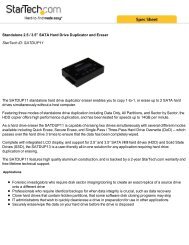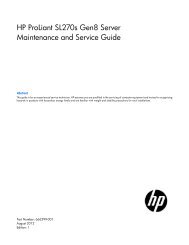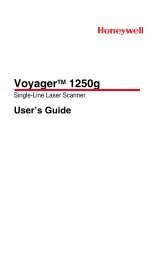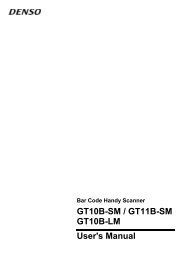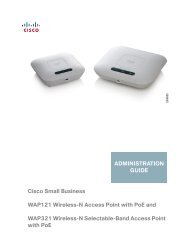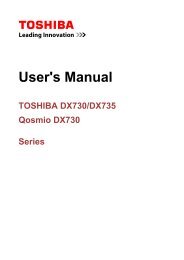User Manual - Etilize
User Manual - Etilize
User Manual - Etilize
You also want an ePaper? Increase the reach of your titles
YUMPU automatically turns print PDFs into web optimized ePapers that Google loves.
might be configured to watch for the operating system watchdog timer and reboot<br />
the system after a timeout, if the ASR feature is enabled. Otherwise, the IMM<br />
allows the administrator to generate a nonmaskable interrupt (NMI) by pressing<br />
an NMI button on the system board for an operating-system memory dump. ASR<br />
is supported by IPMI.<br />
v Intelligent Platform Management Interface (IPMI) Specification V2.0 and<br />
Intelligent Platform Management Bus (IPMB) support.<br />
v Invalid system configuration (CNFG) LED support.<br />
v Serial port redirection over Telnet or SSH.<br />
v Serial over LAN (SOL).<br />
v Active Energy Manager.<br />
v Query power-supply input power.<br />
v PECI 2 support.<br />
v Power/reset control (power-on, hard and soft shutdown, hard and soft reset,<br />
schedule power control).<br />
v Alerts (in-band and out-of-band alerting, PET traps - IPMI style, SNMP, e-mail).<br />
v Operating-system failure blue screen capture.<br />
v Command-line interface.<br />
v Configuration save and restore.<br />
v PCI configuration data.<br />
v Boot sequence manipulation.<br />
The IMM also provides the following remote server management capabilities<br />
through the OSA SMBridge management utility program:<br />
v Command-line interface (IPMI Shell)<br />
The command-line interface provides direct access to server management<br />
functions through the IPMI 2.0 protocol. Use the command-line interface to issue<br />
commands to control the server power, view system information, and identify the<br />
server. You can also save one or more commands as a text file and run the file<br />
as a script.<br />
v Serial over LAN<br />
Establish a Serial over LAN (SOL) connection to manage servers from a remote<br />
location. You can remotely view and change the UEFI settings, restart the server,<br />
identify the server, and perform other management functions. Any standard Telnet<br />
client application can access the SOL connection.<br />
Using the embedded hypervisor<br />
The VMware ESXi embedded hypervisor is available on server models that come<br />
with an installed USB embedded hypervisor flash device. The USB flash device<br />
installs in the USB connector on the system board (see the following illustration).<br />
Hypervisor is virtualization software that enables multiple operating systems to run<br />
on a host system at the same time. The USB flash device is required to activate the<br />
hypervisor functions.<br />
To start using the embedded hypervisor functions, you must add the USB flash<br />
device to the boot order in the Setup utility.<br />
To add the USB flash device to the boot order, complete the following steps:<br />
1. Turn on the server.<br />
Chapter 3. Configuring the server 77




